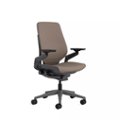Specifications
Product Height44.25 inchesProduct Width34.63 inchesProduct Depth23.63 inchesSeat Height (From Floor)16 inchesMaximum Weight Capacity400 poundsMaximum Seat Height From Floor21 inches
Key Specs
Product Height44.25 inchesProduct Width34.63 inchesProduct Depth23.63 inchesSeat Height (From Floor)16 inchesMaximum Weight Capacity400 poundsMaximum Seat Height From Floor21 inchesMinimum Seat Height From Floor16 inchesSeat Width20 inchesErgonomic DesignYesCaster StyleHard Floor CastersArmrest FeaturesAdjustable depth, Adjustable height, Adjustable width, Pivot, PaddedLumbar Support TypeAdjustableAssembly RequiredNo
General
Product NameGesture Shell Back Office ChairBrandSteelcaseAssembly RequiredNoModel NumberSX40LCQX8Q6562PLN3ColorTruffleColor CategoryTan
Dimension
Product Height44.25 inchesProduct Width34.63 inchesProduct Depth23.63 inchesProduct Weight56.9 poundsSeat Height (From Floor)16 inchesMaximum Weight Capacity400 poundsMaximum Seat Height From Floor21 inchesMinimum Seat Height From Floor16 inchesSeat Width20 inchesBackrest Height24 inchesBackrest Width16.25 inches
Material
MaterialUpholstery, Plastic, MetalFinishTruffleFrame Material(s)PlasticSeat MaterialUpholsteryBackrest MaterialUpholstery
Design
Office Chair StyleExecutive chair, Gaming chair, Desk chairErgonomic DesignYesBase Design5-pointed starCaster(s) IncludedYesCaster StyleHard Floor Casters
Features
Motion TypeSwivelRecliningYesSwivel Angle360 degreesAdjustable Seat HeightYesPneumatic Height AdjustmentYesArmrests IncludedYesArmrest FeaturesAdjustable depth, Adjustable height, Adjustable width, Pivot, PaddedLumbar Support TypeAdjustable
Warranty
Manufacturer's Warranty - Parts12-year warrantyManufacturer's Warranty - LaborN/A
Other
UPC724274000626
Perfect for the endurance sitter and technology power user, Gesture adapts to your every move, and every device you use, to provide ultimate, long-lasting comfort and support for your body. With the most inclusive fit of any chair in our portfolio, everyone feels comfortable sitting in Gesture. Our proprietary seat cushion design leverages built in air pockets that conform to your body and reduce pressure that comes from long term sitting. Gesture’s arms adjust through a full range of motion – 360 degrees – for support that follows you as you work with multiple tech devices and interfaces. Armrests are designed to remain parallel to your work surface as you move, so you can stay comfortably on task at every angle of recline. Gesture’s 3D LiveBack(TM) technology is designed to flex and mimic the natural movements of your spine as you change postures. The contoured shape of the back helps to align your spine in its natural S-shape. Features include adjustable seat depth, fully adjustable arms, adjustable lumbar, seat height adjustment, recline tension adjustment, 4 position recline lock, plastic outer shell-back, upholstered back and seat, and wheels for hard flooring. Arrives fully assembled and is backed by a 12-year warranty.
Upholstery
Era fabric is 100% polyester. Fabric color is Truffle.
Ergonomic Chair Features
Adjustable seat depth, Fully adjustable arms (height, width, depth, pivot), Adjustable lumbar, Pneumatic seat height adjustment, Recline tension adjustment, 4 position recline back lock, Upholstery on seat and back, Dark/dark frame color scheme, Casters for hard flooring
All day comfort and back support
Gesture’s seat and back move as a synchronized system, following your body as you move throughout the day to ensure long-term support.
Quality and Durability
Designed to withstand 24/7 use will providing maximum comfort
Weight capacity tested up to 400 pounds
Exceeds ANSI/BIFMA standards, product safety and perfomance standards developed by the Business and Institutional Furniture Manufacturers Association.
What's Included
Office Chair
Search
Q: QuestionDoes this chair include the additional lumbar support and upholstered wrap back options?(1 answer)
A: AnswerHello! Yes, this chair includes the adjustable lumbar support. Thank you!Answered by Steelcase Team
Q: QuestionWhere is the Gesture chair made?(1 answer)
A: AnswerHello, thank you for your interest in our products. Steelcase products are manufactured across multiple manufacturing facilities in North America, with locations in the United States and Mexico.Answered by Steelcase Team
Q: QuestionWith the delivery option, is the chair delivered fully assembled?(1 answer)
A: AnswerHello. Thank you for your interest in our products. The chair is delivered ready to assemble, meaning the chair comes in three pieces. The installation is really easy and there is no tools needed. Thank you!Answered by Steelcase Team
- A: AnswerHello! Thank you for your interest in our products. This listing has Sterling dark finish, which is a rich gray finish. Thank you.
Answered by Steelcase Team
Q: QuestionDo you carry a lower seat height version (that goes below 16”)?(1 answer)
A: AnswerHi! Gesture chair has three option of cylinders. Low, standard and high. On BestBuy we only offer our standard height cylinder. Thank you!Answered by Steelcase Team
Q: QuestionDoes this model take a headrest? If so how much does that add to the price?(0 answers)
Asked by Brian
Q: QuestionWhat is the diameter of the base (the widest part from wheel to wheel)?(1 answer)
A: AnswerHello, Thank you for your interest in our products. Its about 2.5 ft. Thank you!Answered by Steelcase Team
- A: AnswerHello! Please give us a call to see if we can arrange a visit to our worklife center 616.247.2710 Thank you!
Answered by Steelcase Team
Steelcase - Gesture Shell Back Office Chair - Truffle
Caster Style:
Color:
Shipping
Reviews
Rating 4.6 out of 5 stars with 53 reviews
4.6Rating by feature
- 4.2Value
Rating 4.2 out of 5 stars
- 4.7Quality
Rating 4.7 out of 5 stars
- 4.7Ease of Use
Rating 4.7 out of 5 stars
The vast majority of our reviews come from verified purchases. Reviews from customers may include My Best Buy members, employees, and Tech Insider Network members (as tagged). Select reviewers may receive discounted products, promotional considerations or entries into drawings for honest, helpful reviews.
Rated 5 out of 5 stars
Hands down the best on the market!
Absolutely the most comfortable office chair I have ever owned. Easily adjustable, great back support, comfortable seat even when sitting for long periods of time. Highly recommend!
This review is from Steelcase - Gesture Shell Back Office Chair - Night Owl
Posted by ksprairie
Rated 4 out of 5 stars
Great Chair For Those Willing To Put In The Time
INTRO: I am a software developer. I don’t have the best back, but I often rotate between sitting and standing at my height-adjustable desk. For over 4 years, I’ve been using a generic mesh task chair that cost me $200. The seat was comfortable and breathable, and my arm rests had a fair amount of adjustability. So to migrate from an affordable task chair to a flagship chair like the Steelcase Gesture, you could imagine my excitement. And while overall I do like the Steelcase Gesture, you shouldn’t expect it to be perfect right out of the box. This chair is really meant for those who are committed to developing their seating posture, and that can take time. UNBOXING & SETUP: I had the Gesture shipped to my house, and it came in a 34x27x21 inch box. It was a little unwieldy for me, but I was able to get a grasp on it and bring it into my home. Opening the box, the chair was separated into 3 separate pieces—the wheelbase (with wheels assembled), the seat, and the pneumatic cylinder to connect the two. The easiest way to set up the chair is perhaps to connect the pneumatic cylinder to the wheelbase, then place the seat on its side or back, then connect the other side of the pneumatic cylinder to the seat. At that point, you’ll want to make sure you apply pressure to ensure both the seat and wheelbase are connected. This took me only about a minute or so to assemble. BUILD: In terms of build, the Gesture is well-made. Although it is plastic like most chairs, the rigidity of the plastic is quite good. It’s not rickety like cheaper chairs, and the control mechanisms instill confidence in their build. The fabric is also well-knit without any rips or tears in the seams. ADJUSTMENTS: The Gesture has the most number of adjustments I’ve seen on an office chair. Like all pneumatic chairs these days, you have the height adjustment which can be done simply by adjusting your pressure on the seat and pressing/pulling on the height lever on the front-most knob on the right of the chair. You can also adjust the seat forward and backward by rotating the front-most knob, and you can even do it while seated. So there’s no need to stand up to adjust the seat. Additionally, the backrest can be adjusted via the other knob on the right of the chair. Rotating the knob can adjust the tension required to move the backrest backwards, which is very helpful if you want to sit in an upright 90 degree position, or laxen it up to make it easier to lean back in the chair. This knob also has an adjustable tilt lock that can prevent the backrest from moving beyond a certain point. However, one downside about this mechanism is that the backrest cannot be locked into a specific position—it always returns to a 90 degree upright position when you’re not applying force to lean it backwards. So if you’re used to leaning back into a specific position, the Gesture will not help you do that, and it caught me off guard. There is also a lumbar adjustment slider on the sides of the backrest that can help provide some rigidity, although it doesn’t have the ability to adjust how much rigidity you want to apply at any given position. Lastly, the arms and armrests are probably one of the best features about this chair. The arms can be lifted up and down, they can swivel inward or outward, and the armrests can slide forward and backward as well as rotate, giving you a lot of options to suit your posture. COMFORT: In terms of comfort, I think the Steelcase Gesture is only as good as you can make it. It provides many of the adjustments to create a comfortable seating position, but it doesn’t inherently tell you what those might be. So you really have to dial in each of those parameters and spend some time doing trial and error to achieve good results. While I don’t feel as though I had issues with the seat, my first hour sitting in the chair was not that great for my lower back. And this is really because of the point I just mentioned—you need to find what works for you, and that can take time. As I’ve slowly made more and more adjustments, I’ve begun to find better typing posture thanks to the flexibility of the armrests. And my lower back discomfort has begun to diminish as I’ve worked towards determining what posture is most comfortable for my body. I’ve had experiences where I tried a chair at a store for a limited time, then brought it home to realize that the short-term usage was really not enough to help make a good judgment call. But a chair with as much adjustability as the Steelcase Gesture is likely to be a more confident pick when you bring it home. However, you’ll still need to put in the time to find the best posture for you. CONCLUSION: I’ve used the Gesture for long hours of mixed use (14+ hours) at my desk for work and even gaming and felt quite comfortable in it, overall. But I didn’t come away with the impression that it’s a life-changing chair. People tend to hype up these expensive flagship chairs or say that they “swear by x chair”. But there’s really a lot of companies making well-designed ergonomic chairs, and I don’t think the Steelcase Gesture is necessarily designed for ergonomics as much as it is designed to facilitate different postures—even poor postures. I think many people can appreciate the versatility that the Gesture provides, and if you need a chair where different people are going to sit, it’s nice to choose a chair that can fit the needs of many different body types. So while I think this is a great chair for the right person, it has gotten significantly more expensive over the past several years while competition has become more fierce. So while this is undoubtedly a great chair with a 12-year warranty, I do think it’s at least worth considering other brands before looking to pay this very high price.
This review is from Steelcase - Gesture Shell Back Office Chair - Night Owl
Posted by Xephyroth
Rated 1 out of 5 stars
Steelcase gesture
Horrible, the backrest is misaligned with respect to the rest of the chair. I ordered a replacement and it’s worse than the first one. I have it all documented. The chair feels like it’s made out of grade D recycled materials.
This review is from Steelcase - Gesture Shell Back Office Chair - Night Owl
Posted by MaxE








